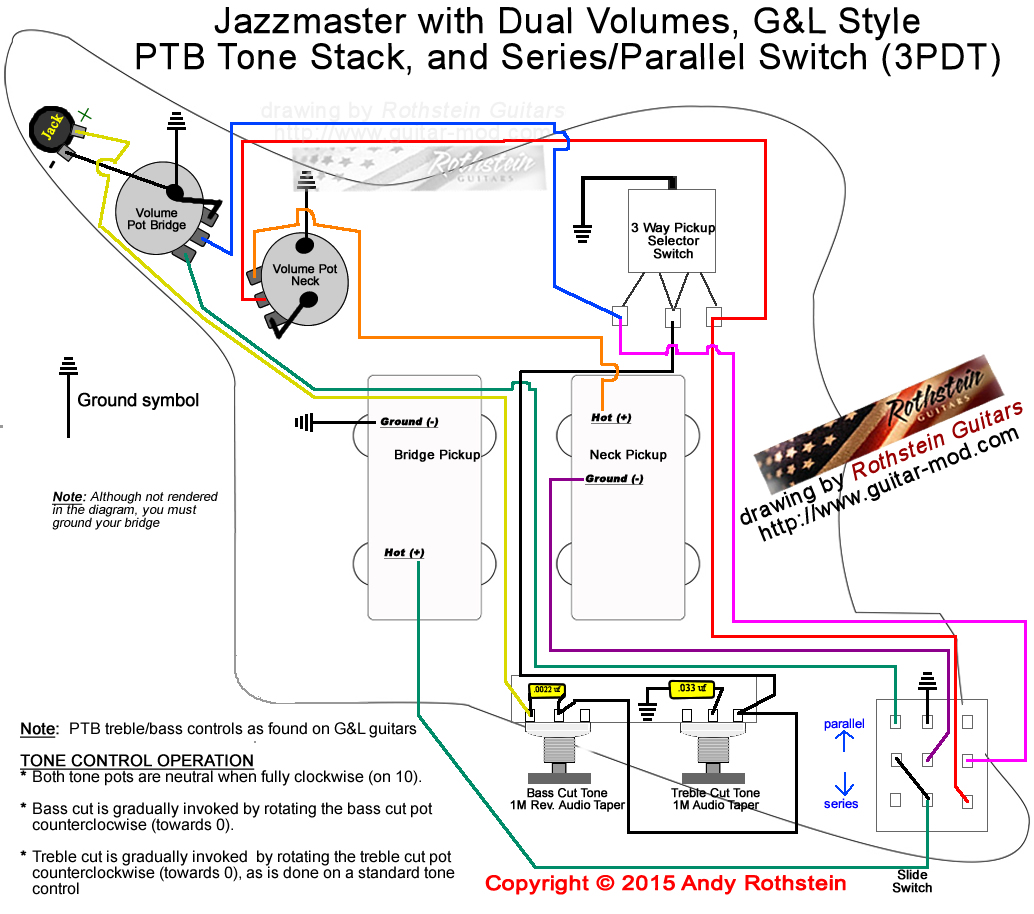JAZZMASTER SERIES/PARALLEL WIRING PAGE
Including: Rothstein Jazzmaster STB Super Mod
with Series/Parallel Switching, Dual Volumes, and PTB Tone
This page provides several diagrams that I have put together, all of which implement series/parallel switching in the Jazzmaster. The one described first is our STB Super mod featuring dual volumes, series/parallel switching, and a G&L style PTB tone stack (passive treble/bass).

DUAL VOLUME CONTROLS
You can easily reconfigure the lead circuit to be more "Les Paul" like by using two independent volume controls, one for each pickup. This will give you the benefit of being able to blend in a percentage of neck pickup along with the bridge pickup
LEO FENDER's PTB SYSTEM
A great tone mod is to use Leo Fender’s PTB tone stack that he developed for some of the G&L guitars. PTB stands for Passive Treble and Bass. One control cuts treble, and the other cuts bass. Both are configured as “master” controls, meaning they affect all pickup switch positions.
The treble cut control is a low pass filter, and functions just like a standard tone control. A low pass filter allows frequencies lower than the cutoff frequency to pass and higher frequencies are rolled off.
The bass cut control is a high pass filter, which is the opposite of a low pass filter. A high pass filter allows frequencies higher than the cutoff frequency to pass, and lower frequencies are rolled off. This ability to dial out some of the low frequencies is extremely useful, particularly to help overdriven sounds stand out. Leo Fender’s design for the bass cut control calls for a 1 meg reverse taper pot with a .002 MFD capacitor. You can experiment with the capacitor value in the range of .001 MFD to .003 MFD. The smaller the capacitor value, the more pronounced the bass cut. However, for the bass cut pot, you really must use a 1M reverse taper pot to get the most usable sweep.
SERIES / PARALLEL SWITCHING
In traditional Jazzmaster wiring, when the two pickups are combined together via the toggle switch, they are done so in parallel. The slide switch can be rewired to enage a series connection, which will provide a significantly different sound. Parallel will be brighter with scooped mids, and exhibit more “quack” and twang. In contrast, series will sound more humbucker-like, in that it will be louder, darker and have more pronounced mids.
MOD VARIATION USING A 3PDT SLIDE SWITCH
There is one unexpected by product of this wiring scheme that some will really like, and other might not. For those who don’t, I have provided a solution below. The feature is that when the series connection is engaged, one of the toggle-switch positions will yield no sound at all, in this case the bridge position. To some, this feature will actually be considered a bonus because you are really getting a kill switch effect. To others, the concept of having one dead toggle switch position when in series mode might not be so desirable. To remedy this situation you will need a 3PDT slide switch, which you can get from mouser electronics (Swithcraft brand / part # 50209LX). Observe the following diagram depicting the extra third pole on the slide switch.
3PDT VERSION

ALTERNATIVE DIAGRAM WITHOUT DUAL VOLUME CONTROLS
I have had a couple of inquiries from players who want series/parallel switching and the PTB tone controls, but prefer not to have dual volumes. I therefore came up with an alternative that does that. It uses 3 pots, namely:
- Master Volume
- Master Tone (treble cut)
- 2nd MasterTone (bass cut)
The Jazzmaster of course has 4 pots, so that would leave you either with 1 dummy pot, or you can devise something useful to do with the 4th pot. I do have a several ideas in mind and I'll update this page with additional diagrams in the near future.

back to Jazzmaster wiring diagrams page




